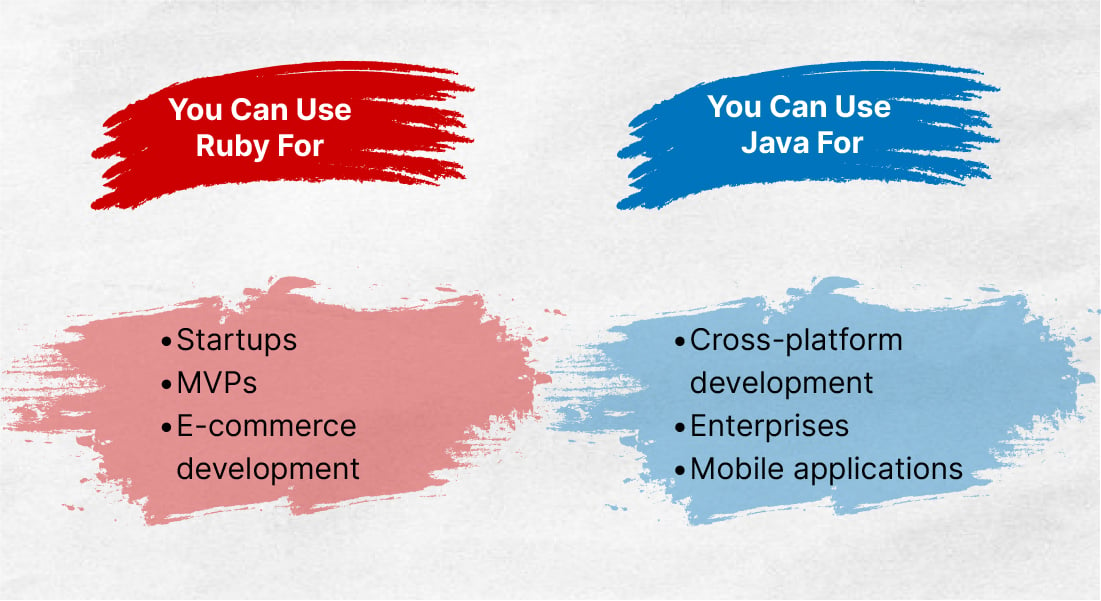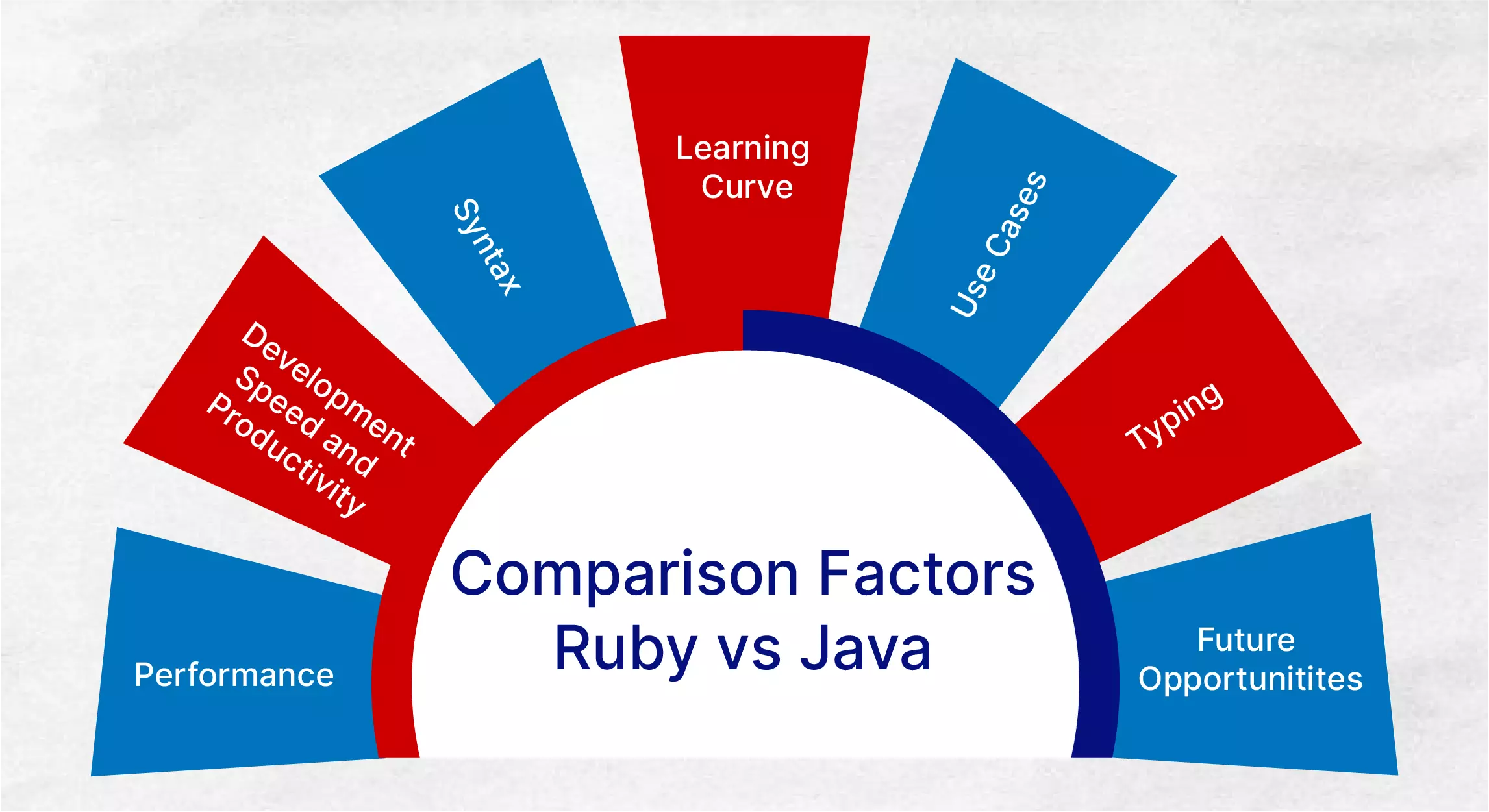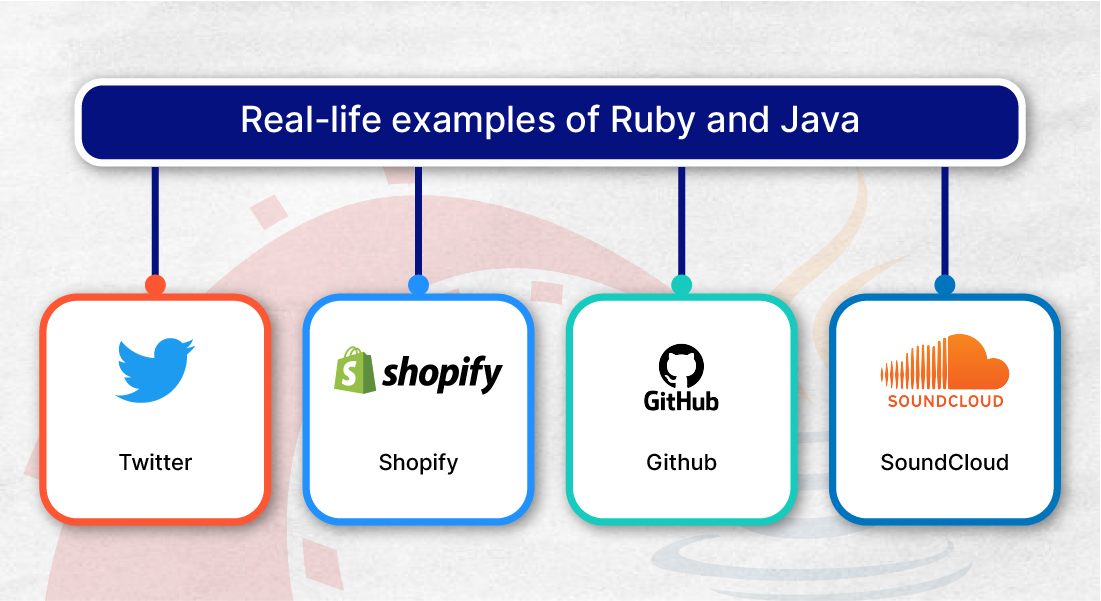| Parameters | Ruby | Java |
|---|---|---|
| Language Types | An object-oriented scripting language | An Object-oriented language |
| Developed by | It was developed by Yukihiro Matsumoto in 1990 | It was developed by James Gosling in 1995 |
| Scalability | It has limited scalable for developing large-scale applications | It is highly scalable for developing enterprise-level applications |
| Frameworks and Libraries | Ruby on Rails, Sinatra, and Camping | Spring, Hibernate, and Apache Struts |
| Compilation | An interpreted language that executes code line by line | A compiled language that converts source code into Bytecode |
| Flexibility and Adaptability | Flexible and easily adaptable by providing runtime modification | Less flexible and focus more on a structured approach to programming |
| Variable Objects | Dynamic typing with no explicit type declarations | Static typing with explicit type declarations |
| Error-handling | Handles errors with expectation handling mechanisms | Handle errors with expectations based on try-catch blocks |
Quick Summary:
In this comparison guide of Ruby vs Java, we delve into the core aspects of these programming languages. On one side, we have Ruby, an excellent programming language with elegant syntax, which focuses on enriching code readability and maximizing productivity. On the other side, there is Java, a versatile language recognized for its strong-typed, comprehensive ecosystem and impressive, extensive libraries.
Table of Contents
Introduction
Do you know there are more than 700 programming languages out there? Yes, and the best among all are Ruby and Java. Let’s look at the statistics– that reveal the entire story:
- 438,555 websites used Ruby
- 56,302 websites used Java
- Over 67% of professional developers prefer Ruby
- With a 41% market share, Java is the most widely-used programming language.
However, it still juggles the question, Ruby or Java, which is ideal for your project?
As both are immensely popular with robust features and several benefits. In this blog, we will cover critical differences between Ruby vs Java, their similarities, when to choose what, and real-life examples.

Ruby vs Java: Comparison Table
Both popular programming languages have immensely similar backend development processes; however, a few differences make a huge impact. Let’s find out the comparison of Java vs Ruby in the below table form:
In-depth Comparison: Ruby vs Java
Let’s briefly analyze the significant difference between Ruby vs Java. Following is an in-depth comparison of Ruby and Java.

? Performance
When it comes to Ruby vs Java performance benchmarks, Java surpasses Ruby. Java’s Bytecode is compiled with machine code run by Java Virtual Machine (JVM), resulting in faster performance execution. At the same time, Ruby is executed line by line, which results in slower performance execution.
Although Ruby has improved its performance optimization techniques, Java is that trend that never will go out of style.
? Winner – Java empowers performance benchmarks compared to Ruby
Need a language that delivers exceptional performance for your application?
Look no further; hire our Ruby on Rails developer to ensure quick turnaround and highly scalable performance
? Development Speed and Productivity
Speed and productivity are the significant factors of backend development. Comparing that, Ruby focuses on conventions that prevent the need to structure, name, and database configurations.
Whereas Java’s reusable and maintainable code decreases redundant work, which helps streamline development using existing solutions. However, the Java compilation process is rigid and requires more design and planning, which leads to a slower initial development process than Ruby.
? Winner – Ruby is faster in development speed and productivity
? Syntax
Ruby has straightforward, elegant, and concise syntax, minimizing unnecessary punctuations and providing developers with clean writing. On the other side, Java is a bit complex and requires explicit syntax, which enables developers to focus on problem domains rather than language.
Ruby is more expressive, natural language-like, and prioritizes readability; simultaneously, Java promotes code readability and maintainability for larger projects. Both offer different syntaxes, yet help enhance development efficiency.
? Winner – Ruby’s minimalist syntax is rapid and easier to comprehend than Java
? Learning Curve
Both programming languages are prominent; their learning curve differs in terms of complexity and the need for familiarity with certain concepts. Ruby is beginner-friendly with its dynamic typing and flexible nature for learners to experiment.
On the contrary, Java has a steeper learning curve and object-oriented programming, making it challenging for beginners. However, Java has a large ecosystem and comprehensive community support for beginners.
? Winner – Ruby’s learning curve promotes a smooth learning experience
? Use Cases
The popular programming languages are implemented in various use cases. Ruby excels in web development, especially using the Ruby on Rails framework, making it an efficient choice for database-driven and interactive websites. Industries like startups, entertainment, and social media use Ruby.
Java is widely used in large-scale applications, server-side development, and enterprise. Its excellent scalability and extensive libraries make it ideal for complex applications. E-commerce, banking, and finance are the industries that adapt Java for applications.
? Winner – Both are winners, as Java and Ruby benefit multiple industries
? Typing
The typing system of Java and Ruby signifies differently based on variable and data types. Ruby is a dynamically typed language that allows variables to hold any value types without requiring explicit type declarations. Additionally, it is flexible by allowing a variable to change its types during runtime.
In contrast, Java is a statically typed language that enables variable types to be explicitly declared and ensures it is verified during compilation. Also, it checked that variables are used consistently with their declared types.
? Winner – Ruby’s dynamic typing provides more rapid development and agility
? Future Opportunities
Ruby and Java are widespread and prominent backend languages in the development world. But coming to future aspects, Java is one step ahead of Ruby regarding future opportunities. Java is a versatile programming language with massive community support of over 10 million developers.
Conversely, Ruby is not as widely used as Java, but it still manages to secure its position in the top 10 most loved programming languages by developers. However, Ruby is a growing language with potential involvement in the software development industry.
? Winner – Java seems to have more future opportunities compared to Ruby
When to Use Ruby or Java?
After understanding the primary differences between Ruby vs Java, let’s make it easier for you by knowing when to use Ruby or Java.
| Factors | When to Choose Ruby | When to Choose Java |
|---|---|---|
| Web Development | Suitable for creating intuitive and interactive websites with the Rails framework | Well-suited for developing robust and scalable web applications with Spring framework |
| Projects | Ideal for startups and small-scale projects | Perfect for large-scale projects |
| Use Cases | Best for web applications | Best for mobile applications |
| Speed of Development | Prefer Ruby when you are looking for minimum viable product development and a shorter duration | Prefer Java when you are looking for long-term stability and scalable development |
| System Integration | Choose Ruby for integrating the existing system into the same technology | Choose Java for extensive system integration through different technology |
Can We Use Java with Ruby?
Yes, we can use Java with Ruby. Both excellent backend programming languages are used to build dynamic apps. Also, by embracing JRuby, you can leverage Java code, libraries, and frameworks within the Ruby application.
In addition, you get the following benefits of when using Ruby with Java for your project:
- Access to Java’s extensive ecosystem and libraries
- Seamless integration into existing Ruby application
- Enhance application performance with Java’s optimization techniques
- Easy cross-platform compatibility, making deployment easier on multiple platforms.
Ruby and Java: Key Similarities
After comparing Java vs Ruby, let’s understand a few similarities between Java and Ruby:
Object-oriented Language
Ruby and Java are object-oriented programming languages. These languages allow developers to structure their code around classes and objects. This approach promotes code usability, enhances maintainability, and simplifies complex application development.
Ruby treats everything as an object, including Boolean and Integers, but Java does not. As a result, Ruby is associated with methods, whereas Java has limited object-oriented features. In addition, several things can be represented as objects apart from primitive types in both languages.
Vast Libraries and Tools
Both programming languages have extensive libraries and tools that improve development productivity. Ruby provides various libraries called ROR gems. It has a comprehensive collection of gems, allowing developers to integrate into projects, leverage existing code, and accelerate development.
Meanwhile, the Java ecosystem, with its libraries and frameworks, covers multiple domains, such as enterprise integration, big data and analytics, and mobile app development. It includes several libraries and frameworks like Hibernate, Apache Commons, and Spring.
Efficient Frameworks
The Java and Ruby frameworks are highly effective and ideal for building web applications. Ruby’s Ruby on Rails is a highly productive web framework with dynamic features like routing, database integration, and less development time.
At the same time, Java has a Spring framework that provides a tremendous suite of modules and libraries for developing enterprise applications, which offers seamless integration and rapid development.
Built-in Security Features
One crucial factor in choosing these two programming languages is their built-in security features. It helps to protect your application against security vulnerabilities. Ruby provides security-focused frameworks and libraries like Devise that can control web apps efficiently. Nevertheless, using Ruby on Rails to build cybersecurity applications is an ongoing trend.
Java provides Bytecode verification that detects potential defects to secure coding practices. Both languages offer robust mechanisms that enable access control, encryption, and authentication.
Ready to empower your app development process?
Get in touch with Ruby on Rails development company to meet your needs and accelerate your project’s success.
Success Stories of Ruby and Java
Let’s look at the real-life examples of Ruby and Java and how they benefit the applications.

This social media platform is a perfect example of using Ruby and Java in their application. Initially, they used Ruby for backend development, which benefits them to maximize productivity and improve development efficiency. Later, Java came into the picture, helping Twitter to handle massive amounts of data and simplify complex algorithms with its efficient backend systems.
Shopify
This e-commerce platform, Shopify has incorporated Java and Ruby to enhance application performance. Ruby was used for backend development, providing core functionality like inventory management and order processing. Java manages complex calculations and integrates with external systems and components.
Github
This code collaboration platform has employed Java and Ruby to perform efficient development processes. Ruby was used for the front end and various application components. Java was incorporated for crucial backend systems handling large-scale data processing.
SoundCloud
This audio streamlining platform leverages Java and Ruby to offer a seamless user experience. Ruby is used for particular APIs and web services that ensure the rapid development of user interfaces. Java ensures performance optimization, scalability, and high-quality audio streamlining experiences.
Conclusion
Regarding the best programming language battle: Ruby vs Java, it is definitely hard to determine one as both have numerous advantages and are developers’ go-to choice for developing dynamic applications.
Ruby is known for its flexibility and ease of use, making it a popular choice for web development and scripting. Meanwhile, Java is more widely used in enterprise applications and is known for its speed and security.
Hence, whether you opt for Ruby’s agility or Java’s scalability, what truly matters is the transformative software you create and its impact on your business.
Frequently Asked Questions (FAQs)
Yes, Ruby and Java can interoperate with each other through various mechanisms. Such as Ruby, which enable using each other code seamlessly.
Yes, Ruby is preferably considered easier to learn than Java due to its simpler syntax and focus on developer productivity.
Both Ruby and Java are exceptional programming languages; hence, the better option depends on the specific project requirements and preferences. Ruby excels in web development, and Java emerges in enterprise-level apps.
Yes, both Ruby and Java can handle cross-platform development. Java enables you to write code once and run it on multiple platforms. On the other hand, Ruby’s frameworks like RubyMotion are used for cross-platform development.
Your Success Is Guaranteed !
We accelerate the release of digital product and guaranteed their success
We Use Slack, Jira & GitHub for Accurate Deployment and Effective Communication.






